She sells seashells down by the seashore.
The shells she sells are surely seashells.
So if she sells shells on the seashore,
I’m sure she sells seashore shells.
As some of you will be aware, I have had my head down for six months or so, trying to get the Salish Sea recognized as a UNESCO World Heritage Site. Just the Canadian waters that is, so it’s only 60 per cent as difficult as getting the whole inland sea on the drawing board.
Though some might say it’s going to be a herculean task to get the U.S. waters onboard in the foreseeable future, so long as certain presidents’ and non-believers in the public’s interest remain in office.
Here, though, we believe the Salish Sea deserves recognition as a UNESCO World Heritage Site. And by April 30, we’re expecting to have about 10,000 people agree with us, signing onto our petition, writing letters to MPs and MLAs, and of course, letting their local government’s know what’s good for Canadians and Salish Sea residents.
It would seem that a lot of people — rich, poor, famous and maybe a few infamous souls as well — all agree that the Salish Sea is an ecological, cultural and economic region with global significance. And that it embodies an iconic Canadian identity that embraces respect for diversity amongst people and nature, communities and cultures. It’s just plain common knowledge, right?
And since World Heritage Sites are exceptional places around the world that help protect the common heritage of humankind, then also recognizing the outstanding universal value of the Salish Sea is a good thing. Voila!
Some radicals, who have been writing to us, even believe that it is increasingly evident that our species, humans, need to be thinking beyond the present and that keeping the ocean healthy, before it spirals down beyond the point of no return, makes sense. I try not to argue with them.
Instead, I talk about a culture that is 10,000 years old. There’s an obligation, I say, as people with conscience, with ethics and values, to recognize and respect a civilization that found a balance with nature — that practiced sustainability millennia before we Europeans discovered the concept. Coast Salish, and the first people of the Salish Sea, have a lot of traditional wisdom we can learn from.
Even the radicals believe that traditional practices and knowledge are a good thing. And most of the non-believers, too. Everyone pretty much concedes that a Salish Sea World Heritage Site would help make our oceans healthy again.
And so I put it to them that we’re on a mission for Canada, for the world, to keep the Salish Sea beautiful and bountiful, to respect the heritage of the First Peoples, to keep our marine areas biodiverse and productive — and to create a future we all share.
Then, by hook or crook, I get them to stand by the seashore. Sometimes I’ll even try to sell them a seashell. Whatever it takes, y’know.
Take a deep breath of the salty sea air! Look across the waters, past the fishing boats and islands, and take a good look at the mountains, ringing the Salish Sea. Remember the last time you were out on a boat or a ferry, felt the swell and splash of the waves, maybe saw an orca, eagle, maybe a humpback whale?
And here we all are now, and what are we going to do? First off, let’s keep it a paradise and thank our lucky stars we’re here.
This is a pivotal time: our legacy moment, our chance to be heroes, to give a little of ourselves, to make a difference for all humankind, for all time.
And then I slip my business card into their coat pocket and tell them to check out our amazing website, and the website our partners, SeaLegacy, have put together, y’know the National Geographic photojournalists who travel the world and live just up the road.
Sometimes people just need a little time down by the seashore to remember why they’re here.
For more information email salishseatrust@shaw.ca or visit www.salishseatrust.ca

